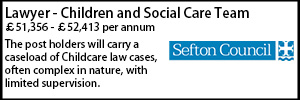Court of Appeal rules on “hot potato” issue of decision between care order, supervision order or no order when child placed at home
- Details
The Court of Appeal has allowed an appeal by a mother and made supervision orders in place of care orders for all three of her children, who are placed at home.
In JW (Child at Home under Care Order) [2023] EWCA Civ 944 Sir Andrew McFarlane, President of the Family Division, said: “For some years it has been recognised that a difference exists in the approach taken by courts in different regions when determining whether a final care order, supervision order or no order should be made when care proceedings conclude with a plan for the subject child to be placed, or remain living, at home with their parent(s).
“Broadly speaking, if a line is drawn from Hull down to Bristol and beyond, courts in England and Wales that are North and West of that line will often make a care order in such cases, in contrast to courts South and East of the line where normally a supervision order or no public law order will be made. My experience is that the judges who sit on one side of the line or the other are confident that the approach taken in their area is the correct one.”
Sir Andrew added: “The difference of approach is striking, and its existence has become something of a hot potato, and increasingly so as Family Courts across England and Wales strive, once again, to conclude public law care proceedings within the statutory 26 week time limit set by Children Act 1989, s 32(1) [‘CA 1989’].”
Outlining the background to the present case, the Family President said the appeal concerned three children: a girl, now aged nearly 14 years, and two boys, now aged 11 and 7 years.
In 2020, the children’s mother (“the mother”) met ‘Mr P’ and the couple married the following year.
Sir Andrew said: “It was only after her marriage that the mother was informed by social services that Mr P had been convicted in 2005 of offences of making and possessing a large number of indecent images of children. He had been made the subject of a Sexual Harm Prevention Order prohibiting him from having unsupervised contact with children.”
In October 2021, “as soon as she had been made aware of this information”, the mother agreed to and signed a safety plan under which Mr P moved out of the family home, said the judge.
However, he added: “In the following months the local social services authority became increasingly concerned that the mother was not adhering to the safety plan and that Mr P was having unauthorised contact with her and the family.”
In May 2022, the local authority issued care proceedings, during which the children remained living at home with their mother under an interim supervision order.
Sir Andrew noted that Mr P, in his position statement to the court, on 11 October 2022, “accepted the mother’s decision to end the relationship and stated he would not contact her. However, behind the scenes he continued to contact the family surreptitiously via the mother’s eldest son.”
At the final hearing in November 2022, HHJ Harris-Jenkins acceded to the submissions of the local authority and children’s guardian by making a full care order with a care plan for the three children to remain living at home.
HHJ Harris-Jenkins concluded: "In my judgment, I am persuaded by the evidence and the submission that I have read and heard, that a Supervision Order does not have the safeguarding features that a Care Order has and which are needed in this case.
“In balancing the competing arguments in this case, it has been a fine balancing exercise. The Local Authority has satisfied me that this is one of those cases in which a Care Order is necessary and a proportionate response. It is exceptionally a case where such an Order is made when the child lives at home with Mother, firstly, because of how recent the breakup of the relationship is (By that, I do not mean just the physical relationship. It is the emotional relationship) and also secondly, the fact that Mr P is still clearly intent, as recently as the 20th October 2022, to press on with getting his message across to [mother] that [he] is not a risk.”
Sir Andrew said: “In reaching that conclusion he took into account the need for the order made to be necessary and proportionate and the need to apply the s 1(5), CA 1989, least interventionist approach. In assessing risk, he took into account the mother’s ‘inordinate’ delay in committing to cut ties with Mr P.”
On behalf of the mother, counsel advanced her appeal of the decision of November 2022 on two grounds:
i) The court was wrong to make final care orders instead of final supervision orders in circumstances where the care plans were for the children to remain at home with their mother.
ii) Alternatively, in the event that the court had considered that more time was required for the mother to evidence the ending of the relationship with Mr P and/or her commitment to the proposed work, the court was wrong not to adjourn the final hearing and extend the proceedings.
On ground one, it was submitted on behalf of the mother that HHJ Harris-Jenkins “had not identified with any specificity what extra safeguard would be provided under a care order, as opposed to a supervision order”.
It was argued that “the judgment, which at no stage refers to the individual children (not even stating how many there were, their ages or gender), does not in any manner specify the risk from which they are to be protected.”
Counsel for the local authority submitted that the judge was “entitled to decide that a care order was justified and it is not possible to hold that he was wrong in doing so”.
She submitted to the Court of Appeal that Mr P was an identified source of serious risk, who would not engage in therapy. Counsel pointed to the fact that the couple’s separation was recent and the children’s mother had yet to embark on the course aimed at enhancing her ability to protect them.
Turning to the issue of the different approaches taken by courts in different regions, the Family President said: “The present situation, in which the law is applied in a markedly different manner in two halves of England and Wales, cannot continue. There needs to be a common approach throughout England and throughout Wales.”
He noted that the recommendations and guidance of the PLWG [Public Law Working Group, chaired by Mr Justice Keehan] could be reduced to the following short points:
- a care order should not be used solely as a vehicle to achieve the provision of support and services after the conclusion of proceedings;
- a care order on the basis that the child will be living at home should only be made when there are exceptional reasons for doing so. It should be rare in the extreme that the risks of significant harm to a child are judged to be sufficient to merit the making of a care order but, nevertheless, as risks that can be managed with the child remaining in the care of parents;
- unless, in an exceptional case, a care order is necessary for the protection of the child, some other means of providing support and services must be used;
- where a child is to be placed at home, the making of a supervision order to support reunification may be proportionate;
- where a supervision order is being considered, the best practice guidance in the PLWG April 2023 report must be applied. In particular the court should require the local authority to have a Supervision Support Plan in place.
Considering the appeal, Sir Andrew said that in the present case, the judge was “fully aware” of the PLWG guidance and recommendations with regard to the making of a care order for a child placed at home. He added: “He expressly referred to it and invited submissions specifically on the point”.
The Family President noted that the situation before the judge was that the three children had always lived with their mother. The sole source of risk to them came from her association with Mr P and the potential for him to cause significant harm to a child as a result of his past history.
He found that HHJ Harris-Jenkins was entitled to hold that the mother had “inordinately delayed cutting her ties with Mr P”.
However, Sir Andrew said: “The judge’s principal reason for making a care order was that a supervision order did not have ‘the safeguarding features’ of a care order and that it was necessary for the local authority to share parental responsibility, and if necessary take the whip hand, if there was a falling down in the safeguarding position at any point. The judge did not, however, identify what ‘the safeguarding features’ of a care order in this case were.
"[...] he did not consider whether, in ‘taking the whip hand’, the authority would be justified in immediately removing the children from their mother’s care. Unless it was likely that immediate removal would be justified, then, on the basis of Re DE, whether the final order was a care order or a supervision order, the issue of removal would have to come back to court."
Concluding on ground one, he said: “In in all the circumstances, the judge was in error in holding that this case was exceptional and that a care order was the proportionate and necessary order to be made.
“For the reasons that I have given, the reality is that, in a case such as this, where the risk is slow burning and the plan for monitoring and support is the same under either order, and where any attempt to remove the children from home would be likely to lead to further court proceedings, there was nothing that making a care order would add to the local authority’s ability to provide protection."
He allowed the appeal on ground one.
However, dismissing the second ground, he said: "Further adjournment in the present case would have been for an open-ended period that would probably include the mother starting and completing the protection enhancement course and demonstrating a substantial period of total separation from Mr P. Extension of the 26-week timetable on such a basis would not be justified."
Sir Andrew allowed the appeal and instructed for supervision orders to be made in place of the care orders for all three children.
Lady Justice Macur and Lord Justice Coulson agreed.
Lottie Winson





















































